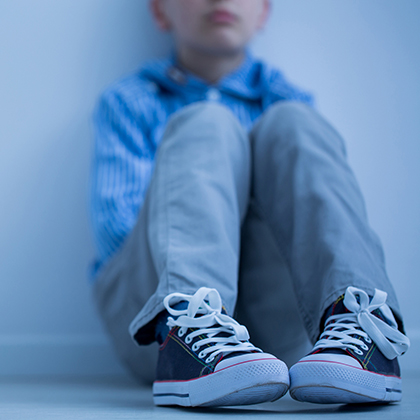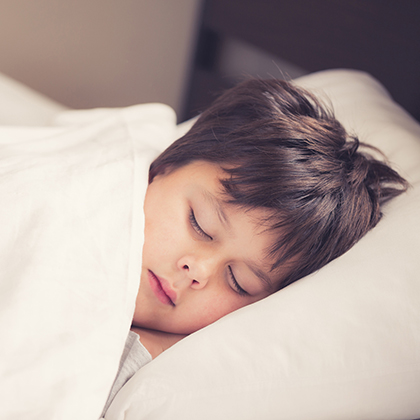
If your child seems to be catching every bug that’s going around, it may be distressing but it’s also normal. After all, children are particularly prone to getting sick when they’re young because their bodies are still building immunity to all those germs they encounter regularly in the school playground.
As a parent, it’s natural for you to want to stop your child ever getting sick. But not only is that very difficult – perhaps even impossible – to achieve, it’s also not advisable. That’s because being exposed to a variety of bugs will make your child’s immune system stronger, which can help them resist a range of illnesses as they get older.
It’s thought most children will catch at least one or more infectious illnesses at some stage. According to the National Institute for Health and Care Excellence (NICE), children experience an average of five to eight colds – which are common causes of ear infections – every year (compared with two to three colds a year in adults) (i).
Routine vaccines are available to protect children against more serious diseases. Many important childhood vaccines are available free on the NHS, with the first ones given when a baby is just two months old (or even earlier, as pregnant women can protect their unborn baby against whopping cough by getting a vaccine, typically when they are 28 - 32 weeks pregnant).
Besides making sure your child receives their vaccinations at the right times, you may want to be aware of the signs and symptoms of common childhood infections. It’s also a good idea to arm yourself with information on what you can do to make your little one feel better when they do bring a bug home from school.
How do infections spread in children?
Bugs that cause illness – or pathogens, to give them their scientific name – can spread easily in schools and nurseries because these are places where children play in close contact with one another. If one child is infected with a bug they can infect others through the air when they cough or sneeze. Infections can also be transmitted by objects or surfaces that an infected child has touched, coughed or sneezed over – if your child touches one of these objects or surfaces and then puts their hand on their mouth, nose or eyes, they can then become infected with the same bug.
This is why health experts recommend that parents teach their children good hygiene practices – including keeping their hands as clean as possible – early on, especially before they start nursery, day care or school. Other helpful hygiene practices you can pass on to your child include coughing or sneezing into their elbow, not sharing cups or cutlery and throwing used tissues into the bin immediately after use.
When should you take your child to a doctor?
While many common childhood infections can be treated easily at home, it’s important to get professional medical advice if you’re concerned in any way about your child. Also take them to see their GP if your child doesn’t start to improve after a day or two of being looked after at home, if their symptoms are getting worse, or if any of the following apply:
-
They have pain that doesn’t get better after taking children’s paracetamol or ibuprofen.
-
They have a high temperature that doesn’t improve within five days (see our guide to Children’s health: fever or high temperature for more essential details).
-
They’re having persistent vomiting and/or diarrhoea (that is, they have vomited three or more times or have had diarrhoea six or more times in 24 hours).
-
They refuse to drink anything or can’t keep liquids down.
-
They’re producing fewer than half their usual number of wet nappies.
-
They are aged three months or younger and have a fever or aren’t feeding as well as usual.
Take them to see their doctor straight away or call for an ambulance if…
-
They are having breathing difficulties.
-
They look very pale and are hard to wake.
-
They have a rash combined with a headache, stiff neck or back pain.
-
They have a rash or spots that don’t disappear when you place the side of a clear glass against them (read our guide to Septicaemia and meningitis in children to find out more details about the danger signs to look out for).
Sore ears and eyes
Ear infections
What are the symptoms of an ear infection in a child?
Most ear infections are caused by viruses – often cold viruses – which means they will get better by themselves without antibiotics or other treatments. They are particularly common in babies and smaller children, though most grow out of having ear infections as they get older.
If your child has an ear infection they will usually have a sharp, dull or burning pain in one ear or both of their ears that either comes and goes or is constant. They may also have a high temperature. Meanwhile you can spot an ear infection in a baby or toddler if they pull or rub at one of their ears, or if they seem irritable and unwilling to feed and are restless at night.
Most childhood ear infections tend to pass after three days or so, but if your child has earache that has lasted for longer, or if they have other symptoms such as a very sore throat, hearing loss, discharge from the ear or vomiting, take them to see their GP. It’s also advisable to take a child to see their doctor if they have earache and are three months old or younger.
How can I treat my child's ear infection?
-
A children’s pain relief medicine containing either paracetamol or ibuprofen can help ease the pain of an ear infection.
-
Also make sure they drink lots of fluids.
-
If your child is old enough to use pillows, give them an extra one at night as it may help them to sleep better.
-
Keep them away from cigarette smoke – this can help prevent ear infections too, since experts have found children who live in smoke-free homes are less likely to experience earache (ii).
Find out more by reading our guide to Earache and Ear Pain.
Eye infections
What are the signs of conjunctivitis in children?
Conjunctivitis is particularly common in children, and is often known as red eye or pink eye. This can make a child’s eye or eyes look red and weepy, and feel itchy, sore and gritty. They may also have crusting on their eyelid and/or a sticky substance in the corner of their eyes that’s usually more noticeable when they wake up in the morning.
Conjunctivitis is infectious and is easily passed on from one child to another – if one child with conjunctivitis rubs their eyes then touches the hands of another child, the other child can get conjunctivitis too if they then rub their eyes. So if your child does have conjunctivitis, it’s important that they wash their hands regularly to stop the infection spreading to others. The infection can also be passed from child to child if they share things like towels.
Most cases of conjunctivitis aren’t serious, but conjunctivitis can occasionally cause complications if it isn’t treated. So if you notice any redness in your child’s eyes that doesn’t improve after a couple of days, take them to see their GP. Also seek medical help if your child also has problems with their vision or any swelling in the eyelids and around the eyes, or if they are also generally unwell and have a fever.
How do you treat conjunctivitis in a child?
-
Clean your child’s eyes using boiled water that has been left to cool – soak a cotton wool pad (one for each eye if both eyes are infected) in the cooled water, and gently wipe their eyelashes in an outwards direction to clean off any crusts that have developed there.
-
Dispose of any used cotton wool pads immediately, then wash your hands.
For more information, take a look at our guide to conjunctivitis.
Natural support for children's immunity
You may not be able to stop your child going down with a bug, but there are things you can do to support their immune system while they’re sick and to help keep their immunity strong when they’re well.
Good nutrition is important for keeping your child as healthy as possible, which means keeping their immune system healthy too. So try to make sure they get at least five portions of fruit and vegetables every day, as this means their body will be getting a good range of nutrients.
You may also want to consider giving them a multivitamin and mineral supplement – especially if they are a fussy eater. Choose a good-quality supplement designed for children that will give them all the important vitamins and minerals their immune system needs. If they don’t like swallowing tablets there are other options, such as effervescent multivitamin and mineral tablets that dissolve in water to make a pleasant-tasting drink, as well as tasty chewable multivitamin and mineral tablets (look for one that’s kind to their teeth).
Not sure what to choose? Take a look at our guide to Multivitamins for children to help you decide.
High-strength fish oils You may also want to consider giving your child a fish oil supplement, since the omega-3 fatty acids found in oily fish such as salmon, herring, mackerel and sardines are widely thought to be helpful for children’s general health (plus they’re ideal for kids who don’t like the taste of fish). Fish oil supplements often tend to be quite large, so look for one that comes in a small capsule size that a child can swallow easily.
Elderberry Grown on the Sambucus tree, elderberries have a long traditional use for the relief of colds and flu. Look for a good-quality, naturally sweetened elderberry liquid that your child will love to take straight off the spoon.
Vitamin C This is an important vitamin that’s needed for many body processes. Experts also believe that not getting enough vitamin C may weaken a child’s immune system (iii). You can find vitamin C in multivitamin and mineral supplements, but it’s also available as a single supplement.
Zinc We all need zinc for a healthy immune system, but many of us – including children – may not be getting enough of it in our diets. Foods that contain good levels of zinc include meat, shellfish, legumes, nuts, seeds, dairy foods, eggs and whole grains. If your child doesn’t eat many zinc-rich foods, a supplement may be the answer. Most good-quality multivitamin and mineral supplements will contain a decent level of zinc, but you could also try giving them zinc lozenges (these not only taste nice but you can get them with added vitamin C too).
Vitamin D Children need to get the right amount of vitamin D for their immune systems to function normally. These days, the government recommends that all children from birth to four years old take a daily vitamin D supplement throughout the year, while those who are four years and older should take it during the autumn and winter months (though there’s a good argument for giving children of any age vitamin D supplements all year round if they don’t spend much time outdoors in the spring and summer months or if they usually wear clothes that cover up most of their skin when they’re outdoors).
Again, you can give your child the vitamin D they need in a good multivitamin supplement. Alternatively there are vitamin D supplements available – and if your child doesn’t like taking tablets, you can give them vitamin D drops.
It’s never easy for parents when their children are sick, but having common mild infections such as ear and eye infections is normal and it even makes their immunity stronger and healthier. Knowing the difference between a mild infection you can treat at home and something that may be more serious is essential for all parents – plus it can also be helpful to know how to soothe their symptoms when you’re looking after them. There’s lots more information on children’s and adults’ health conditions in our pharmacy health library – why not take a look around?
References:
(i) Available online: https://cks.nice.org.uk/topics/common-cold/background-information/prevalence/(ii) Available online: https://patient.info/ears-nose-throat-mouth/earache-ear-pain/ear-infection-otitis-media#nav-3
(iii) Maggini S, Wenzlaff S, Hornig S. Essential role of vitamin C and zinc in child immunity and health. J Int Med Res. Mar-Apr 2010;38(2):386-414. Available online: https://journals.sagepub.com/doi/10.1177/147323001003800203
Related Posts
Disclaimer: The information presented by Nature's Best is for informational purposes only. It is based on scientific studies (human, animal, or in vitro), clinical experience, or traditional usage as cited in each article. The results reported may not necessarily occur in all individuals. Self-treatment is not recommended for life-threatening conditions that require medical treatment under a doctor's care. For many of the conditions discussed, treatment with prescription or over the counter medication is also available. Consult your doctor, practitioner, and/or pharmacist for any health problem and before using any supplements or before making any changes in prescribed medications.

Christine
Christine Morgan has been a freelance health and wellbeing journalist for almost 20 years, having written for numerous publications including the Daily Mirror, S Magazine, Top Sante, Healthy, Woman & Home, Zest, Allergy, Healthy Times and Pregnancy & Birth; she has also edited several titles such as Women’ Health, Shine’s Real Health & Beauty and All About Health.
View More



